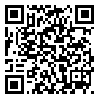Volume 2, Issue 1 (2011)
JMBS 2011, 2(1): 0-0 |
Back to browse issues page
Download citation:
BibTeX | RIS | EndNote | Medlars | ProCite | Reference Manager | RefWorks
Send citation to:



BibTeX | RIS | EndNote | Medlars | ProCite | Reference Manager | RefWorks
Send citation to:
Cheraghi S. Cloning of LysA gene in expression vector in order to increase the production rate of L-lysine. JMBS 2011; 2 (1)
URL: http://biot.modares.ac.ir/article-22-12356-en.html
URL: http://biot.modares.ac.ir/article-22-12356-en.html
Sara Cheraghi *  1
1
 1
1
1- Tehran
Abstract: (11973 Views)
Background: L-lysine is essential amino acid for human and animal nutrition. L-lysine is useful as medicament, chemical agent, food material (food industry) and feed additive (animal food). The industrial production of lysine has become an economically important industrial process. Several hundred thousands tones of L-lysine are produced annually worldwide, almost exclusively using Corynebacterium glutamicum.
Study methods: To amplify LysA gene from C.glutamicum, two primers with NheI and HindIII restriction sites were designed. PCR was performed and PCR product was ligated with pTZ57R/T. Recombinant plasmid sequence was determined. LysA with sticky end was ligated with digested pET28a vector and ligation mixture was transformed in E.coli BL21(DE3). The recombinant plasmid was isolated with enzymatic digestion and sequencing.
Results: LysA gene, a fragment with 1.3 kb, was cloned. PCR products and enzymatic digestion of extracted vectors with HindIII and NheI, sequencing and SDS-PAGE confirmed the authenticity of cloning. Recombinant bacterial colonies were investigated and confirmed by two methods (PCR and enzymatic digestion).
Conclusion: In this study for the first time, the expression rate of Meso- diaminopimelate decarboxylase enzyme (EC 4.1.1.20) in this expression vector was investigated and was increased significantly.
Keywords: "pET28a", " Corynebacterium glutamicum", "Diaminopimelate decarboxylase enzyme"- "pTZ57R/T "
Article Type: Research Paper |
Subject:
Biotechnology
Received: 2010/12/25 | Accepted: 2011/05/23 | Published: 2011/09/19
Received: 2010/12/25 | Accepted: 2011/05/23 | Published: 2011/09/19
| Rights and permissions | |
 |
This work is licensed under a Creative Commons Attribution-NonCommercial 4.0 International License. |






